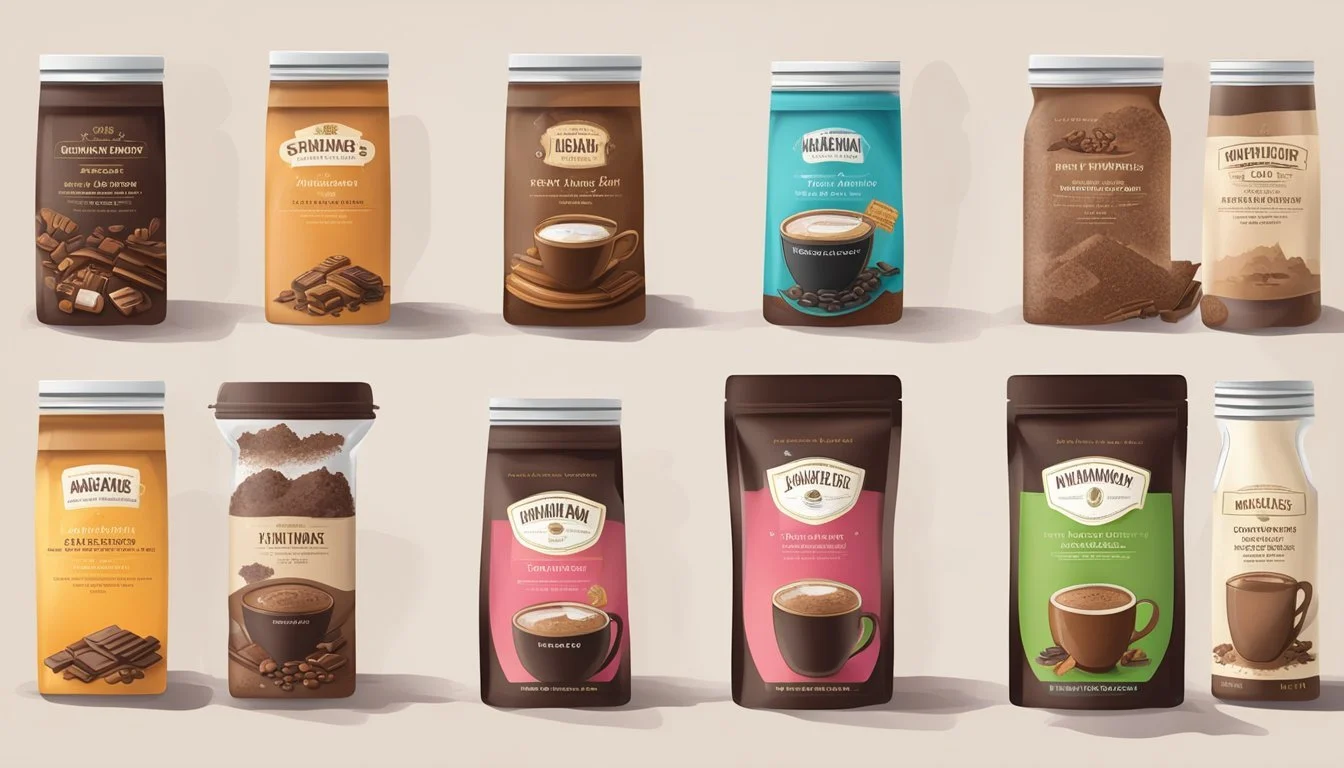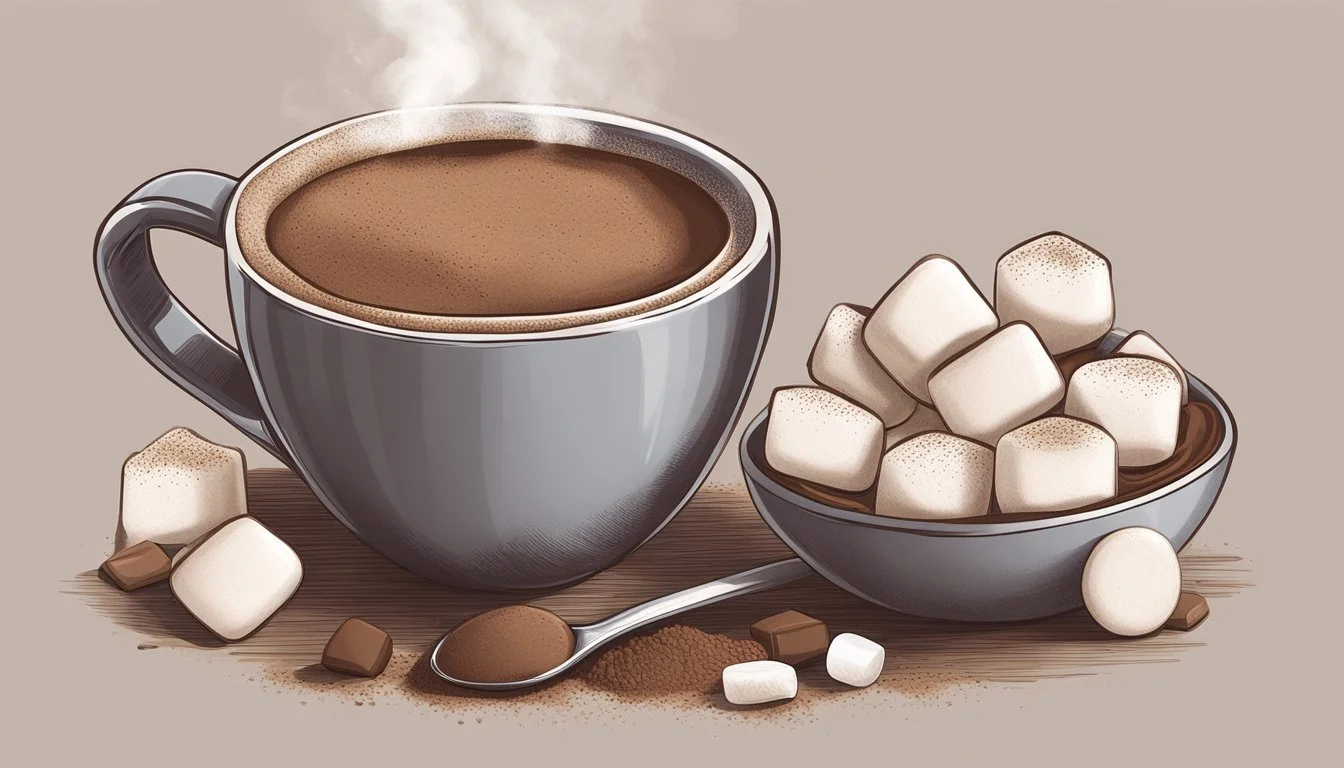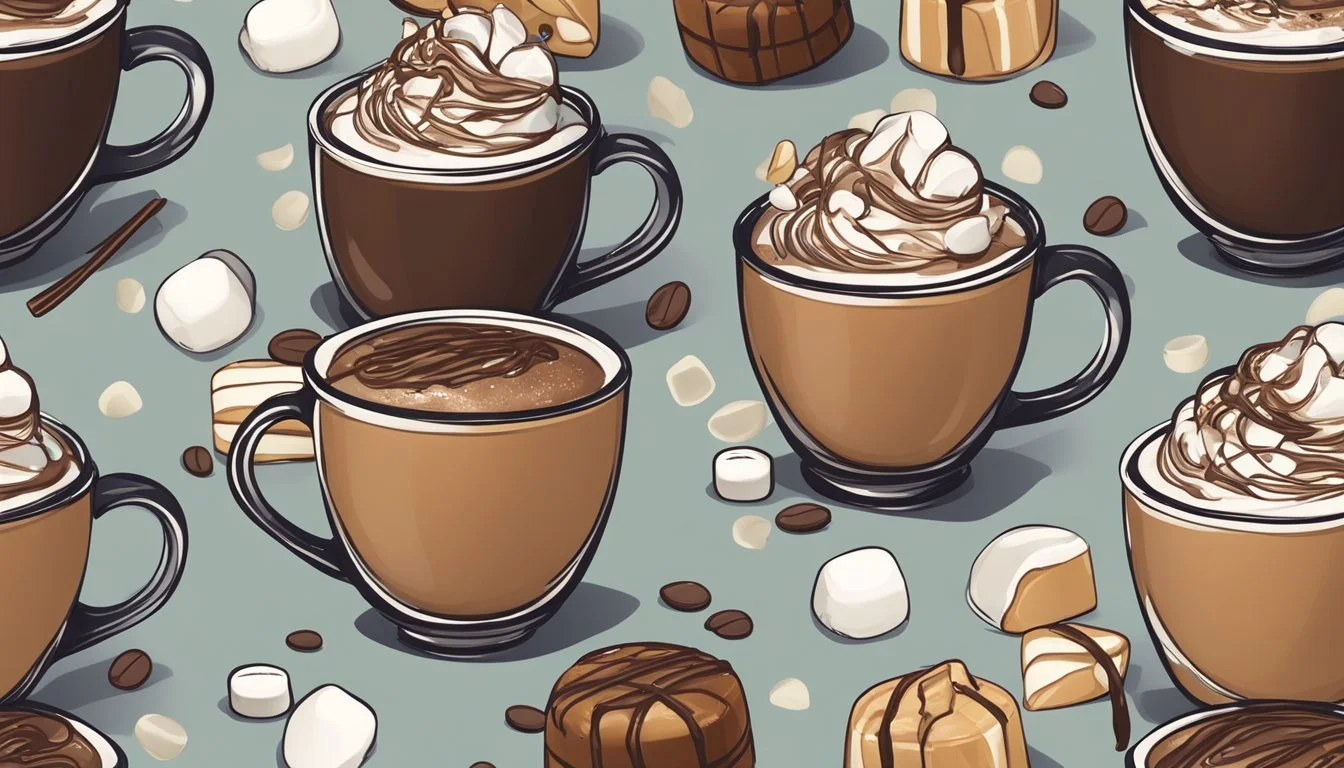Instant Hot Chocolate Mix-Ins
Enhance Your Warm Beverage Game
Instant hot chocolate (What wine goes well with chocolate?) is a beloved beverage praised for its convenience and comfort, especially during the colder months. At its core, it is a sweet, chocolate-flavored drink made by mixing cocoa with hot milk or water, often coming in a pre-mixed powder form. Individuals seek to enrich this simple pleasure with various mix-ins to enhance its flavor and texture. This adaptability makes hot chocolate a versatile canvas for culinary creativity.
Experimenting with different add-ins can transform a standard cup of hot cocoa into a delightful treat that tantalizes the taste buds. A dash of spices such as cinnamon, nutmeg, or cardamom can introduce a warm complexity, while a pinch of sea salt may elevate the chocolate's inherent richness. For those looking for a creamier consistency, ingredients such as Nutella or malted milk powder are popular choices. Each addition is an opportunity to customize the hot chocolate experience to personal preferences, creating a unique and indulgent beverage.
History and Evolution of Hot Chocolate
Hot chocolate has transitioned from an ancient ritual beverage to a modern day comfort drink, with the development of instant varieties catering to the convenience of contemporary life.
From Ancient Times to Modern Days
In the beginning, chocolate was a far cry from the sweet, creamy drink people enjoy today. The journey began with the indigenous populations of Mesoamerica who fermented, roasted, and ground cocoa beans into a paste to mix with water, creating a frothy, spicy drink revered for its vitality and ceremonial importance. Through the ages, chocolate has undergone significant transformations, notably after its introduction to Europe where it was sweetened and hot milk was added, crafting a beverage embraced by the elite for its luxurious taste.
In the 19th and 20th centuries, chocolate saw further changes as technological advances allowed for a smoother, more homogenous product, giving rise to various types of drinking chocolate. This also heralded the era of milk chocolate and the eventual creation of organic chocolate options, catering to health-conscious consumers seeking natural ingredients. The presence of chocolate in the form of a warm, comforting cup of hot cocoa is often tied with nostalgic sentiments, bringing to mind memories of cold winter days warmed up by a mug of hot chocolate.
Rise of Instant Hot Chocolate
Era Development Early 1900s Introduction of refined chocolate processing. Mid-1900s Invention of instant hot chocolate by Charles Sanna.
The trajectory of hot chocolate saw a pivotal turn when Charles Sanna brought instant hot chocolate to the American consumer market. Sanna's product, known popularly as Swiss Miss, transformed the labor-intensive task of chocolate drink preparation into a swift, effortless activity. This empowering shift met the fast-paced lifestyle of the 20th century, offering a quick, comforting beverage with the simple addition of hot water or milk. The instant hot chocolate phenomenon exploded, leading to an assortment of flavors and blends that today line supermarket shelves worldwide, affirming hot chocolate's enduring appeal.
Ingredients and Nutrition
When crafting an instant hot chocolate mix, the selection of ingredients affects both the flavor profile and nutritional value. This section dissects the components typically found in hot chocolate mix and evaluates their nutritional impact.
Understanding Ingredients
Instant hot chocolate mixes generally contain a combination of sugar, cocoa powder, and often milk powder. Milk chocolate mixes have a sweeter, creamier taste due to the addition of milk chocolate, which contains both cocoa solids and milk solids. In contrast, dark chocolate chunks or chocolate chips may be included for a more intense chocolate flavor and a higher cocoa content.
Furthermore, additives such as mono and diglycerides, dipotassium phosphate, cellulose gum, and sodium citrate play roles as emulsifiers, stabilizers, and preservatives. Soy lecithin is another common emulsifier that helps to maintain a smooth consistency. Some mixes may also incorporate hydrogenated coconut oil or corn syrup for texture and sweetness, while sugar substitutes like sucralose can be found in sugar-free options.
For a more ethical option, fair trade certified ingredients like sugar and cocoa ensure that the products have been sourced responsibly, supporting sustainable farming practices and fair conditions for workers.
Nutrition and Caloric Content
The nutritional profile of an instant hot chocolate mix can vary greatly depending on the specific ingredients used. A basic mix may contain:
Ingredient Calories per Serving Fiber Added Sugars Sugar High 0g High Cocoa Powder Moderate 1-3g Low Milk Powder/Dry Milk Moderate 0-1g Moderate Chocolate Chips High 1-2g High Additives/Preservatives Low/None 0g Low/None
In general, the caloric content of a hot chocolate mix comes primarily from sugar and milk chocolate, with calories ranging from moderate to high. Dark chocolate and pure cocoa powder contribute antioxidants but are also calorie-dense. Products marked as "low-fat" or "reduced calorie" often contain sucralose or other artificial sweeteners to cut down on sugar content.
For those concerned about nutrition, some mixes might include sodium caseinate, a milk derivative that boosts protein content, or cellulose gum, which can add fiber. While these ingredients serve functional purposes, it is the sugar, milk chocolate, and potential hydrogenated oils that contribute most to the calorie count and possible health considerations. It's essential to check labels for a complete breakdown of both macronutrients and micronutrients.
Types of Instant Hot Chocolate
The variety of instant hot chocolate mixes available caters to a wide range of preferences, from classic chocolate flavors to premium blends, and includes options for those with dietary restrictions.
Classic Chocolate Flavor
Classic instant hot chocolate is beloved for its comforting milk chocolate taste. The traditional formula often features a blend of sugar, cocoa, and milk or dark chocolate powder, delivering a straightforward and rich chocolate flavor. This variety is widely accessible and a staple for chocolate lovers seeking a quick and easy warm beverage.
Premium and Gourmet Varieties
For those desiring a more intense cocoa experience, premium and gourmet hot chocolate mixes feature high-quality ingredients such as Dutch-processed cocoa or finely ground dark chocolate. These mixes may contain chunks of real chocolate, enhancing the depth and richness of the flavor. Some gourmet options also include spices such as cinnamon or chili for a unique twist.
Dietary and Allergen-Free Options
Consumers with specific dietary needs can find gluten-free and allergen-friendly hot chocolate mixes that cater to their requirements without compromising on taste. There are mixes available that substitute traditional milk base with rice, soy, or almond milk powder for a milk chocolate flavor suitable for those with lactose intolerance. Additionally, white chocolate variants provide an alternative for those who prefer a sweeter, creamier option that's still within the hot chocolate spectrum.
Customizing Your Hot Chocolate Experience
Enhancing a mug of instant hot chocolate depends on incorporating flavor, texture, and visual appeal through well-chosen add-ins and toppings. Here are some specific ways to transform your hot chocolate from simple to extraordinary.
Creative Mix-In Concepts
Starting with the base of any instant hot chocolate, one can infuse a richer or more intricate taste by bringing in a variety of ingredients. For a creamy twist, vanilla extract can add depth, while peppermint extract introduces a refreshing zing. Cinnamon and nutmeg provide a warming spice profile that complements the chocolate.
Spices: Cinnamon, nutmeg
Extracts: Vanilla, peppermint
Pairs and Toppings
Marshmallows and whipped cream are popular not only for their taste but also for the delightful contrast in texture they add to the smooth beverage. A creative spin includes using mini marshmallows or a garnish of crushed candy canes, which can also add a pop of festive color.
Table: Topping Combinations
Topping Style Whipped Cream + Cinnamon Classic Marshmallows + Crushed Candy Canes Festive Caramel Drizzle + Whipped Cream Luxurious
Flavor Enhancements
To further tailor the flavor profile of your hot chocolate, consider blending in caramel for a buttery note or using mint extract for a cool sensation. One should be cautious with extracts; a little goes a long way. For those who prefer their hot chocolate on the spicier side, a pinch of cayenne can offer a surprising kick.
Sweet: Caramel sauce, marshmallows
Spicy: Cayenne
Minty: Peppermint extract, crushed candy canes
Preparation Techniques and Equipment
Creating the ideal cup of instant hot chocolate requires attention to technique and the use of proper tools. A smooth, well-blended hot chocolate experience starts with understanding how to combine and heat your ingredients for that perfect sip.
The Perfect Hot Chocolate Texture
To achieve a velvety texture, one must carefully blend the cocoa mix with the chosen liquid. Start by whisking the hot chocolate mix into a small amount of milk or water, until a paste forms, ensuring the powder dissolves completely and no lumps remain. Gradually add the remaining liquid, continually whisking to maintain a smooth consistency. Premium brands like Swiss Miss or Starbucks often have instructions specific to their formulations, which typically call for hot milk for a richer taste. For an even more luxurious version, one might turn to sipping chocolate, which is denser than regular cocoa mixes and might include actual chocolate pieces that require thorough heating and whisking.
Tools of the Trade
Whisks are indispensable in the preparation of hot chocolate for they promote a creamy texture and prevent ingredient separation.
Tool Use Whisk Integrates mix with liquid, removes lumps, and creates a smooth texture Measuring Spoons Ensures the precise amount of mix-ins are used Microwave Safe Mug Heats the chocolate mixture quickly and evenly Saucepan Used for stovetop preparation, offering controlled heating Milk Frother Adds air into the mix for a foamy top layer
For those who enjoy specialty mixes like Sillycow, the equipment mentioned aids in enhancing the hot chocolate experience. Whether one prefers the convenience of a microwave or the control offered by a stovetop method, these tools ensure a consistently high-quality outcome.
Exploring Hot Chocolate Variations
The Instant Hot Chocolate experience is greatly enhanced by the incorporation of diverse mix-ins. From gourmet twists to international flavors, each addition offers a unique opportunity to transform a simple cup of hot cocoa into a specialty beverage.
Gourmet and Specialized Recipes
Gourmet hot chocolate recipes often incorporate luxurious ingredients to elevate the classic drink. A dash of espresso can add a sophisticated coffee kick, perfect for coffee enthusiasts. For a spicy twist, one might stir in cayenne or chili powder, adding just enough heat to balance the sweet cocoa flavor. Those with a penchant for richness might opt for melt-in-your-mouth additions like butterscotch syrup or caramel sauce, creating layers of decadence in each sip.
To capture the essence of fall or winter, maple syrup can lend a comforting, woodsy sweetness. For something nuttier, just a few drops of almond extract can significantly enhance the beverage's aroma and taste. Those looking to indulge can add a spoonful of malted milk powder for a hint of nostalgic, creamy maltiness.
Key Mix-Ins
Espresso: Intensifies the chocolate with a coffee flavor.
Cayenne/Chili Powder: Offers a pleasantly spicy surprise.
Butterscotch Syrup: Provides gooey, buttery notes.
Maple Syrup: Infuses a touch of hearty sweetness.
Almond Extract: Gives a fragrant, nutty quality.
International Hot Chocolate Delicacies
Internationally, hot chocolate is also enjoyed with a variety of unique ingredients that reflect local flavors and traditions. Chai tea, for instance, infuses hot chocolate with aromatic spices like cinnamon, cardamom, and ginger, which are staples in many South Asian countries. In Latin America, dulce de leche might be swirled into the mix, adding a creamy, caramel-like sweetness that's hard to resist.
For an Italian twist, some may fold in a spoonful of Nutella, creating a rich, hazelnut-infused beverage. In France, you might find hot chocolate served with a side of raspberry jam, providing a tart contrast to the sweet chocolate. Those looking for holiday cheer might enjoy the North American tradition of peppermint hot chocolate, complete with mint chocolate chips or a candy cane stirrer.
Some adventurous souls might even infuse their cocoa with spirits such as bourbon or whiskey for added warmth and complexity. Others prefer a scoop of ice cream for a deliciously melty concoction. The possibilities are endless, and they invite cocoa lovers to explore the world cup by cup.
International Favorites
Chai Tea: Spices up the cocoa with fragrant Indian spices.
Dulce de Leche: Introduces a creamy, caramelized twist.
Nutella: Merges chocolate with the richness of hazelnuts.
Raspberry Jam: Adds a fruity dimension to the sweet beverage.
Peppermint Hot Chocolate: Brings in a refreshing, minty coolness.
Hot Chocolate in Culinary Context
Hot chocolate as a beverage complements a wide range of foods and desserts and is utilized in professional culinary settings for its rich and chocolatey taste. The versatility of hot chocolate allows for a multitude of combinations that can cater to varying preferences, whether for an indulgent treat or a refreshing beverage.
Pairing with Foods and Desserts
When pairing hot chocolate with food, one should consider the balance of flavors. For a more decadent experience, rich desserts such as brownies or chocolate cake enhance the cocoa's intensity. On the other hand, the contrast of sweet and salty can be achieved by pairing with buttery pastries or salted nuts. To accentuate the beverage, toppings like Ghirardelli chocolate sprinkles or a dash of cinnamon can be added. One may also find options for dairy substitutions like silk or coconut milk, which offer a lighter and sometimes fruity dimension to the flavor profile.
Sweet Pairings:
Chocolate cake
Brownies
Doughnuts
Salty Pairings:
Salted nuts
Pretzels
Dairy Alternatives:
Coconut milk
Silk (soy milk)
Hot Chocolate in Professional Settings
In a professional setting, the presentation and quality of hot chocolate are paramount. Restaurants and cafés might conduct a taste test to select a premium mix that often contains a higher cocoa content and, in some cases, modified whey to achieve a richer texture. For instance, an instant hot cocoa mix used in a reputable restaurant will likely be a runner-up to the actual beverage prepared with whole milk and quality chocolate. The scent plays an essential role too; a comforting, chocolatey aroma is often a crucial aspect of the hot chocolate served in these establishments. Many places might stock Walmart's selection for convenience, but upscale restaurants often prefer specialty brands. The use of instant hot cocoa allows for a quick and efficient service without compromising on a luxurious and satisfying experience for the customer.
Key Aspects in Professional Settings:
Premium instant hot cocoa mix
Comforting scent
Efficient service
Quality ingredients: Whole milk, specialty chocolate







